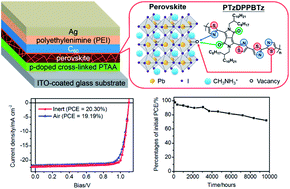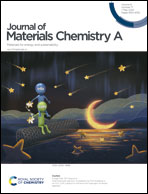Enhanced stability and performance of air-processed perovskite solar cells via defect passivation with a thiazole-bridged diketopyrrolopyrrole-based π-conjugated polymer†
Abstract
The minimization of the defects at grain boundaries and/or the film surface of organic–inorganic halide perovskites is becoming increasingly important to produce highly efficient and long-term stable perovskite solar cells (PeSCs). In this study, we present a promising strategy to enhance the performance and stability of PeSCs by using a thiazole-bridged diketopyrrolopyrrole (DPP)-based semiconducting polymer poly{3-(5-([2,2′-bithiophen]-5-yl)thiazol-2-yl)-2,5-bis(2-octyldodecyl)-6-(thiazol-2-yl)pyrrolo[3,4-c]pyrrole-1,4(2H,5H)-dione} (PTzDPPBTz) as the passivation layer. Our results indicate that a large number of Lewis base functional groups present in PTzDPPBTz can effectively passivate the defects and vacancies created by under-coordinated Pb atoms without significantly altering the microstructure of the perovskite film, enabling the perovskite film to exhibit superior stability while preserving its good optoelectronic properties. Meanwhile, the appropriate energy level of PTzDPPBTz can facilitate efficient charge transfer at the interface. With the PTzDPPBTz passivation layer, the devices deliver a power conversion efficiency (PCE) of up to 20.30% (stabilized PCE = 20.39%) without photocurrent hysteresis, surpassing the efficiency of the devices without a passivation layer (PCE = 16.58%). Importantly, the PTzDPPBTz passivation layer can also be applicable for air-processed devices prepared at a high relative humidity level (72 ± 3%), delivering an almost comparable PCE (19.19%) to those obtained for the devices processed under an inert atmosphere. To the best of our knowledge, 19.19% represents the highest PCE ever reported for air-processed PeSCs prepared at relative humidity exceeding 70%. In addition, the feasibility of using a conjugated polymer-based passivation layer for monolithic all-perovskite tandem solar cells is first demonstrated, and a remarkably high open-circuit voltage (Voc) of 1.87 V is attained, which is much higher than those of the tandem cells without passivation (1.76 V). More encouragingly, long-term stable devices are demonstrated by simply applying a UV-curable epoxy/poly[perfluoro(4-vinyloxy-1-butene)] (CYTOP) bilayer film as the encapsulation layer, retaining ≈65% of their initial PCE after 890 hours of continuous operation in ambient air. Our findings provide a new avenue to improve both the efficiency and stability of air-processed PeSCs via defect passivation.



 Please wait while we load your content...
Please wait while we load your content...